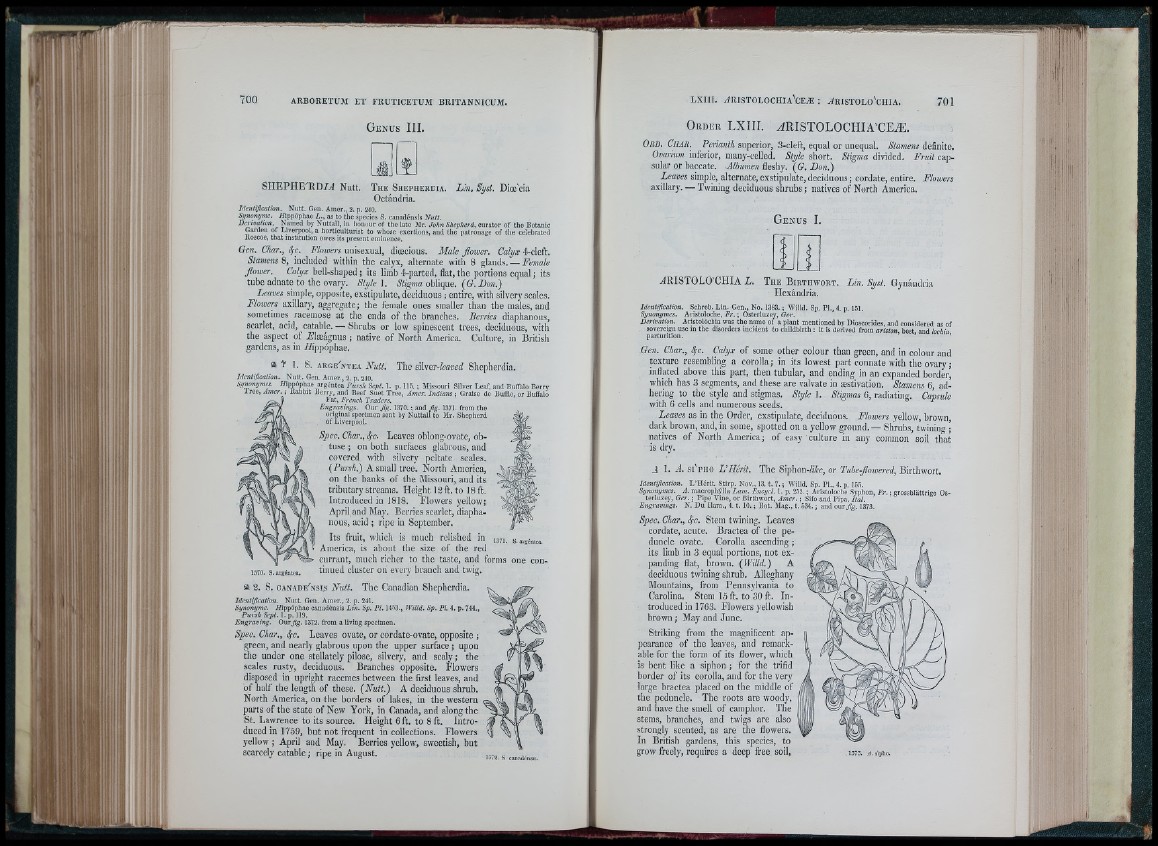
t e
t ?
'■'i
i
G enus III.
SHEPHE'RD/rt Nutt. The S h e p h e r d i a . Lin. Syst. Dioe'cia
Octândria.
Identification. Nult. Gen. Amer., 2. p. 240.
Synonyme. //ippóphae /»., as to the spedes S. canadénsis Nuit.
DcrtvaUon. Named by Nuttall, in honour of the late Mr. John Shepherd, curator of the Botanic
Garden of Liverpool, a horticulturist to whose exertions, and the patronage of the celebrated
lloscoe, that institution owes its present eminence.
Gen. Char., 4<^. Floivers unisexual, dioecious. Male fiower. Calyx 4-cIeft.
Stamens 8, included within the calyx, alternate with 8 glands. — Female
fiower. Calyx bell-shaped; its limb 4-parted, flat, the portions equal; its
tube adnate to the ovary. Sty le ]. oblique. (G.Don.)
Leaves simple, opposite, exstipulate, deciduous ; entire, with silvery scales.
Flowers axillarv, aggregate; the female ones smaller than the males, and
sometimes racemose at the ends of the branches. Berries diaphanous,
scarlet, acid, eatable. — Shrubs or low spinescent trees, deciduous, with
the aspect of iílaeágnus ; native of North America. Culture, in British
gardens, as in //ippophae.
afe ¥ 1. S. a rg e 'n te a Nutt. The silver-ZectiieZ Shepherdia.
Identification. Nutt. Gen. Amer., 2. p. 240.
Synonymes. Hippóphae argéntea Fursh Sept. 1. p. 11.5. ; Missouri Silver Leaf, and Buffalo Berry
ire e , Amer. ; Rabbit Berry, and Beef Suet Tree, Amer. Indians ; Graise de Buffle, or Buffalo
'' Fat, French Traders.
Engravings. Our fig. 1370. ; and fig. 1,371. from the
original specimen sent by Nuttall to Mr. Shepherd
of Liverpool.
Spec. Char., 4c. Leaves oblong-ovate, obtuse
; on both surfaces glabrous, and
covered with silvery peltate scales.
(Pursh.) A small tree. North America,
on the banks of the Missouri, and its
tributary streams. Height 12 ft. to 18 ft.
Introduced in 1818. Flowers yellow;
April and May. Berries scarlet, diaphanous,
acid ; ripe in September.
Its fruit, which is much relished in
America, is about the size of the red
currant, much richer to the taste, and forms one con-
1370. s. argéntea. tiiiucd clustcr Oil evci'y bi’ancli and twig.
Sk 2. S. canade'nsi)» Nutt. The Canadian Shepherdia.
Identification. Nutt. Gen. Amer., 2. p. 241.
Synonyme. flìppóphae canadénsis L in. Sp. Pl. 1453., Willd. Sp. Pl. 4. p. 744.,
Pursh Sept. 1. p. 119.
Engraving. Oar fig. 1372. from a living specimen.
Spec. Char., 4c. Leaves ovate, or cordate-ovate, opposite ;
green, and nearly glabrous upon the upper surface ; upon
the under one stellately pilose, silvery, and scaly ; the
scales rusty, deciduous. Branches opposite. Flowers
disposed in upright racemes between the first leaves, and
of half the length of these. (Nutt.) A deciduous shrub.
North America, on tbe borders of lakes, in the western
parts of the state of New York, in Canada, and along the
St. Lawrence to its source. Height 6 ft. to 8 ft. Introduced
in 1759, but not frequent in collections. Flowers
yellow ; April and May. Berries yellow, sweetish, but
scarcely eatable ; ripe in August.
1371. S. argéntea.
O r d e r LXIIÍ. .4RISTOLOCHIA'CE.3S.
0 / lD . C u A R . Perianth superior, 3-cleft, equal or unequal. Stamens definite.
Ovarium inferior, many-celled. Style short. Stigma divided. Fruit capsular
or baccate. Albumen fleshy. (G. Don.)
Leaves simple, alternate, exstipulate, deciduous; cordate, entire. Flowers
axillary. — Twining deciduous shrubs; natives of North America.
n i i i i
G e n u s I.
.((RISTOLO'CHIA L. T h e B i r t h w o r t .
Hexândria.
Lin. Syst. Gynándria
Identification. Schreb. Lin. Gen., No. 1383. ; Willd. Sp. Pl., 4. p. 151.
Synonymes. Aristoloche, Fr. ; Osterluzey, Ger.
Derivation. Aristolùchia was the name ol a plant „ , . . . ....... m—e--n-t-i-o--n-e d by Dyi Dosicooscorides, and considered as of
ouruicigu uBc lA the disorders incident to childbirth : it is derived from ariston, best, aud lochia,
Gen. Char., 4^^' Calyx of some other colour than green, and in colour and
texture resembling a corolla; in its lowest part connate with the ovary;
inflated above this part, then tubular, and ending in an expanded border!
which has 3 segments, and these are valvate in æstivation. Stamens 6, adhering
to the style and stigmas. Style 1. Stigmas 6, radiating. Capsule
with 6 cells and numerous seeds.
Leaves as in the Order, exstipulate, deciduous. Flowers yellow, brown,
dark brown, and, in some, spotted on a yellow ground.— Shrubs, twining ;
natives of North America; of easy culture in any common soil that
is dry.
Jl 1. A. si'piio L ’Hérit. The Siphon-Zz/ic, or Tube-fiowercd, Birthwort.
Identification. L ’Hérit. Stirp. Nov., 13. t. 7. ; Willd. Sp. Pl., 4. p. 155.
Synonymes. A. macrophÿlla Lam. Encycl. 1. p. 252. ; Aristoloche Syphon, Fr. : grossblattrige Osterluzey,
Ger. 5 Pipe Vine, or Birthwort, Amer. ; Sifo and Pipa. Hal.
Engravings. N. Du Ilam., 4, t. 10. ; Bot. Mag., t. 534. j and oar fig . 1373.
Sjiec. Char., 4c. Stem twining. Leaves
cordate, acute. Bractea of tbe peduncle
ovate. Corolla ascending ;
its limb in 3 equal portions, not expanding
flat, brown. (Willd.) A
deciduous twining shrub. Alleghany
Mountains, from Pennsylvania to
Carolina. Stem 15 ft. to .30 ft. Introducedin
176.3. Flowers yellowish
brown ; May and June.
Striking from the magnificent appearance
of the leaves, and remarkable
for the form of its flower, which
is bent like a siphon ; for the trifid
border of its corolla, iind for the very
large bractea placed on the middle of
the peduncle. The roots are woody,
and have the smell of camphor. The
stems, branches, and twigs are also
strongly scented, as are the flowers.
In British gardens, this species, to
grow freely, requires a deep free soil.